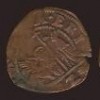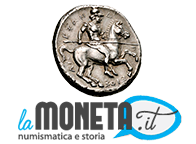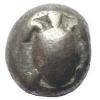Cerca nel Forum
Risultati per Tag 'imitazione'.
Trovato 2 risultati
-
Nella discussione dedicata alla prossima asta CNG, è emersa questa particolare attribuzione a una civetta del tipo ateniese. http://www.cngcoins.com/Coin.aspx?CoinID=334145: CNG 105, Lot: 448 EGYPT, Pharaonic Kingdom. Uncertain pharaoh(s). Mid 5th–mid 4th centuries BC. AR Tetradrachm (22.5mm, 17.01 g, 9h). Imitating Athens. Helmeted head of Athena right, with frontal eye / Owl standing right, head facing; olive sprig and crescent to left; all within incuse square. Van Alfen, Mechanisms, Group III.A.1 = Buttrey Type X. VF, lightly toned, minor die wear, mark on obverse. Imitazioni egiziane di civette ateniesi sono effettivamente note, in particolare nel periodo di dominazione achemenide della regione, ma presenterebbero tratti distintivi ben più evidenti rispetto alla moneta oggetto della discussione (non sono molto informato sull'argomento, pertanto non escludo anche altre attribuzioni basate esclusivamente sullo stile). Per esempio, questa moneta ex The New York Sale, Auction XL, Lotto 1145, oltre allo stile "particolare", presenta la legenda "Artaserse Faraone", scritta in demotico (lingua e scrittura egizia prevalentemente destinata al popolo), che ne permette un'agevole attribuzione all'area egiziana. https://www.acsearch.info/search.html?id=3595920 continua...
- 8 commenti
-

VENEZIA Ducati a Ceylon
fabry61 ha aggiunto un nuovo link in Monete della Serenissima Repubblica di Venezia
Alvise Mocenigo III 1722-1732 Venetian Gold Ducat Alvise Mocenigo I was the elected Doge of the Venetian republic between 1570-1577. Venetians were current in Lanka in the 16th century, and known in Sinhala as Vilisiyanu Kasi. The Inventario do Thesouro do Rei de Ceylao of the King's treasure at Kotte plundered by the Portuguese in 1551 makes mention of 6005 cruzados and Venetians. The Portuguese about 1596 capturing five elephants laden with larins and two with Venetians said to have numbered 100,000. SPECIFICATIONS Denomination Ducat Alloy Gold.999 Type Struck Diameter 21.6 mm Thickness 1.3 mm Weight Legal 3.494 gms Weight ~3.50 gms Shape Round Edge Plain DieAxis O° Mint Venice Friedberg #1263 Obverse : The Doge receiving the gonfalon at the hands of Saint Mark. Along the periphery the legends, S.M.VENET. on left ALOY MOCE on right continued by DVX to the right of the vertical banner which has no flag or cross on top. Reverse : The Standing figure of Christ in Glory facing forward with right hand bent upwards within convex lens known as a mandorla with 13 stars with 6-points along inner periphery. The legend SIT T XPE DAT QTV REGIS ISTE DVCAT along the periphery has no dots and expands to Sit tibi, Christe, datus, quem tu regis, iste ducatus which translates as "To thee, O'Christ, duchy, which thou rulest, be dedicated". It was called a Ducat, the name inscribed on it, but later known as zecchino or sequin. Varying only a little in design it was minted for over 500 years from 1284 till the end of the republic in 1797. The extreme 0.999 purity of the Gold made it a World currency. It was a standard of weight 53.75 grains Troy, or 3.4940 grams with 0.1122 oz of AGW (Actual Gold Weight). Codrington lists the sequins of following Doges during the Portuguese Era as been found in Lanka. F1246 1523-1539 Andrea Gritti .AND.GRITI 9 stars 5-point F1255 1556-1559 Lorenzo Priuli LAV.PRIOL 12 stars 5-point F1263 1570-1577 Alvise Mocenigo I ALOY.MOCE 13 stars 6-point F1270 1585-1595 Pasquale Cicogna PASC.CICON 19 stars 5-point The VF Ducat was scanned at 600dpi and displayed at 300dpi. This sequin was not found from circulation in Lanka. It was purchased on ebay in 2001 January from Classical Numismatic Group, Inc. in Lancaster Pennsylvania who guarantees it's authenticity. This Ducat is exactly as illustrated in Le Monete Di Venezia by Papadopoli, the definitive publication on coins of Venice. Various changes in design offer a means of identifying each ducat uniquely. The lettering in the legend and the presence of . or *'s, the character of the Doge's cap, the disposition of the figure of Christ and the nimbus in the oval, the number and arrangement of the stars and the number of points in each star. The presence or absence of a beard, evidently depended upon the appearance of the individual Doges. On reverse the legend had the word DVCAT which changed after 1655 to DVCA. The staff had nothing or a small flag on top and changed after 1659 to a cross. Between 1655 to 1659 there was a new doge every year and coincides with this transition. Note the abbreviation of the name and the difference of a . or a * of the four Doges with the name Alvise Mocenigo. F1263 1570-1577 Alvise Mocenigo I ALOY.MOCE 13 stars 6-point F1358 1700-1709 Alvise Mocenigo II ALOY*MOCENI* 16 stars 6-point F1379 1722-1732 Alvise Mocenigo III ALOY*MOCENI. 16 stars 6-point F1421 1763-1779 Alvise Mocenigo IV ALOY.MOCEN. 16 stars 5-point It is listed by Codrington's 1914 catalog of Coins in the Colombo Museum, with a description which matches IV. Note the illustrations of Alvise Mocenigo III and IV in Krause are probably in error as different from that in Papadopoli. The Ducat above is before 1600 and not listed in Krause. Text edited from * Ceylon Coins and Currency By H. W. Codrington. Colombo 1924 Page 169 Chapter XIII Miscellaneous - II Venetian * The Venetian Gold Ducat and its Imitations by Herbert E. Ives, edited and annotated by Phillip Grierson. ANS 1954. Posto questo interessante articolo che ho trovato in internet. Quanto meno per i riferimenti bibliografici. Buona Lettura. Fabry
Lamoneta.it
La più grande comunità online di numismatica e monete. Studiosi, collezionisti e semplici appassionati si scambiano informazioni e consigli sul fantastico mondo della numismatica.
Il network
Hai bisogno di aiuto?




